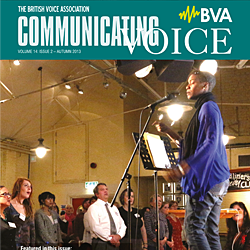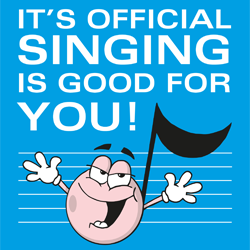About the Association
Archived book reviews
 Ultimate Vocal Voyage
Ultimate Vocal Voyage
Daniel Zangger Borch
Reviewed by Dane Chalfin, March 2008
I was very excited for the chance to review Daniel Zangger Borch's book on contemporary vocal technique and it certainly does not disappoint. Daniel's straight-forward writing style and his lack of uber-scientific language is refreshing, especially in the current climate of nomenclature-overkill. I have not seen another book on pop and rock singing that covers such a wide variety of topics from practical vocal anatomy to vocal distortion to the rigours of the pop/rock vocalist's life.
Daniel's advice on posture is exactly what contemporary singers want. It is un-fussy, concise and realistic. He addresses sitting posture as well as standing which is equally important for the pop/rock singer. A physio I work with said, "The drawing of good standing posture is dreadful!" and I am inclined to agree as it clearly demonstrates rolled shoulders and a protruding neck. Funnily, the drawing of good sitting posture shows much better alignment. My only other concern in this chapter (and throughout the book) is the unleashing of the dreaded "D" word when we are encouraged to "point our diaphragm forward". Without being too pedantic, I would be more comfortable referring to this area as what is (the top of rectus-abdominus) or even a more generic term like "solar plexus", as any reference to the diaphragm is likely to cause confusion or worse propagate the myth that the diaphragm is under our direct control when singing.
The advice on breathing brings up a very important word: balance! Daniel rightly advises singers to keep the torso, abdominal and lower back muscles working in a flexible way and touches gently on the "elastic recoil" when he reminds us to release all of the breathing muscles at the ends of phrases. He also touches very lightly on the connection between the abdominal force and the closed phase of the vocal folds. I would have like to see him elaborate on this relationship more as some research suggests that the breath will respond to the vibratory pattern of the vocal folds and the effort in the larynx. I think it is necessary today to help pop/rock singers understand how little force of breath is required to sustain thick fold sounds as overloading the folds with breath in high-intensity singing can contribute to vocal fold trauma. Singers could misconstrue Daniel's use of the phrase "high lung pressure" when discussing high intensity sounds as a call to drive breath. It might be wise to consider discussing the vocal fold mass and/or closed phase length and an explanation of the difference between sub-glottic pressure and volume of breath. The habit of de-emphasising breath in some major contemporary pedagogies may not always be the best solution, but again, like Daniel, I think balance is the key.
Daniel's preference for low larynx warm-ups is apparent but he does not give specific reasons for the lowered position. The "hot potato" reference concerns me, as does the lack of suggested muscle strategy for lowering the larynx. Lowering the larynx by depressing the tongue as suggested in the potato exercise will certainly cause a power struggle between the body-builder-like tongue base and the less brawny supra-hyoids that needs to raise the larynx to help accommodate ascending pitch. The unwinnable battle against the tongue can often lead to vocal fatigue and lack of top notes. I hope Daniel considers adding an exploration of tongue isolation exercises and muscle strategies for larynx lowering in his second edition to clear up this issue.
It is wonderful to see a vocal coach emphasise the importance of body energy (effort) especially when it comes to warming up. The physical effort pop/rock singers need to maintain healthy high-energy singing is an area that most other writers on this subject have unfortunately ignored. Perhaps the book's most original technique feature is the section on self-massage. Daniel very responsibly urges the singer to be gentle when performing massage techniques on areas including the tongue base, jaw and sternocleidomastoids.
The discussion of the vocal folds and onsets includes the use of slack vocal folds or the "creaky" onset, which though technically not an onset, is an important style tool for most contemporary singers. Renaming the glottal onset a "hard" onset seems unnecessary, as it is a staple term in the world of voice both classical and contemporary. The word "hard" when associated with this onset causes me a little concern, as many teachers have to encourage singers, particularly in pop/rock, to decrease the pressure singers may be using when producing a glottal onset.
I like that Daniel makes a point of distinguishing the difference between breathy singing as a style choice and poor closure or "leaky" voice as he calls it. As breathy singing is increasingly popular in pop/rock, it is vital that we distinguish between vocal style choices and poor vocal function.
Danil's description of vocal registers will sit more comfortably with industry-based singers than our medical/research-minded colleagues. While terms like "chest" and "falsetto" register are still the generic industry standard terms, I would like see a more specific exploration of vocal fold mass, particularly the difference between thin-fold modal and traditional stiff-fold falsetto set-ups. It is interesting, and possibly very industry-appropriate, that there is more discussion of "alternative" sounds like vocal distortion and growl than of clean tone sound options.
Daniel's book really comes into its own in the very concise chapters on the rigours of singing professionally and on voice disorder/clinic procedures. To my knowledge, this is the only book on popular singing to address these issues in such a user-friendly way. I wish that vocal fold cysts and granulomas were included in the voice disorder chapter, but Daniel covers most of the major players, including nodules, polyps and haemorrhages.
The accompanying exercise CD shows off the exceptionally credible voices of both Daniel and his wife. There is no doubt why Daniel has had a long, successful career as a singer and as a vocal coach. This was particularly refreshing for me as many demonstration CD's included with so-called "pop" singing books feature terribly inappropriate classical and/or cabaret sounding exercises and song excerpts. The production on the backing tracks is crisp and the use of riffs from well-known pop repertoire makes the CD even more enjoyable.
Ultimate Vocal Voyage is the first book of its kind to show great pop singing technique presented by a great pop singer. Daniel's commitment to research and multi-disciplinary approaches to voice are apparent and a welcome change in the world of "celebrity-heavy", "evidence-light" world of popular singing training products. Though the book is not without inaccuracy or controversy, it is a gigantic leap in the right direction for products of this nature. I encourage all voice teachers, both pop and classically orientated, to add this book to their collection.
More archived content online
Disclaimer
Neither the British Voice Association nor the Editor can be held responsible for errors or any consequences arising from the use of information contained in its newsletters (or extracts from its newsletters published online); the views and opinions expressed do not necessarily reflect those of the British Voice Association (BVA) or the Editor, neither does the publication of advertisements constitute any endorsement by the BVA or Editor of any products or services featured.

 Join us Now!
Join us Now! our newsletter
our newsletter free voice care leaflets & information – download here
free voice care leaflets & information – download here Help our work by donating while you shop
Help our work by donating while you shop